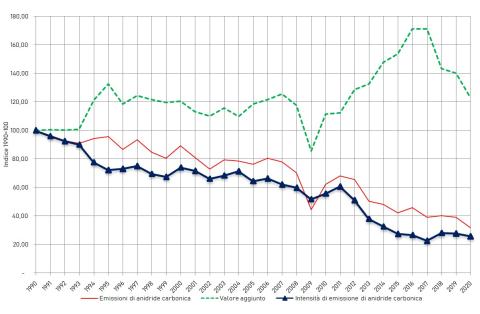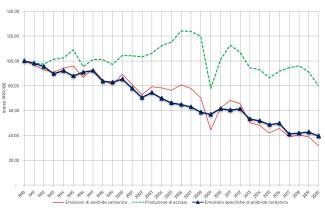Panel 1
Antonella Bernetti
This section presents the carbon dioxide emission intensity in the steel industry in Italy, analyzed with respect to both the sector's value added and steel production. Over the period from 1990 to 2020, a decrease of 74.3% in value added and 60.4% in steel production is recorded. These indicators, developed for the period 1990-2020, are communicated annually to the European Commission as part of the Community's greenhouse gas monitoring mechanism and for the implementation of the Kyoto Protocol during the commitment periods. CO2 emissions from the steel industry decreased by 68.3% from 1990 to 2020. In 2020, emissions decreased by 18.55% compared to the previous year.
The carbon dioxide emission intensity of the steel industry is presented by relating CO2 emissions from the combustion of fossil fuels required for production processes—including emissions from combustion for electricity and thermal energy generation—to both the sector's value added (at base prices, chained values, 2015 reference year) and steel production. Therefore, the indicator provides information on the tons of CO2 emitted per million euros of the steel sector's value added and per ton of steel produced, for the period 1990-2020.
The purpose is to provide, on a regular basis, information on the main causes and highlight the progress made at the national level in various sectoral areas, from a socio-economic and environmental perspective. To provide data on the tons of carbon dioxide emitted per million euros of the steel sector's value added and per ton of steel produced.
Regulation (EU) No. 525/2013, Implementing Regulation (EU) No. 749/2014, Commission Decision No. 2005/166/EC. Regulation (EU) No. 525/2013, which repeals Decision No. 280/2004/EC, establishes in Article 7(1)(f) that by January 15 of each year (year X), Member States must report to the Commission information on carbon dioxide emission intensity indicators, as defined in Annex 3 of the same Regulation, referring to year X-2, for priority, supplementary priority, and additional indicators (indicators as provided in Article 3(1)(j) of Decision No. 280/2004/EC). Implementing Regulation (EU) No. 749/2014 of the Commission of June 30, 2014, addresses the structure, format, transmission procedures, and review of information provided by Member States in accordance with Regulation (EU) No. 525/2013 of the European Parliament and the Council. Commission Decision No. 2005/166/EC of February 10, 2005, establishes the application modalities of Decision No. 280/2004/EC of the European Parliament and the Council concerning the Community's greenhouse gas emissions monitoring mechanism and the implementation of the Kyoto Protocol. The Decision establishes the monitoring of all anthropogenic greenhouse gas emissions, evaluating progress in meeting the commitments made under the United Nations Framework Convention on Climate Change and the Kyoto Protocol, and ensuring the timeliness, completeness, accuracy, consistency, comparability, and transparency of Community and Member State reporting.
Panel 2
APAT, 2008. Carbon Dioxide Intensity Indicators. http://www.isprambiente.gov.it/contentfiles/00004100/4151-co2intensityi…
FEDERACCIAI, various years. The steel industry in figures. Italian Steel Industry Federation. http://www.federacciai.it/
ISPRA, various years. Carbon dioxide intensity indicators available at the link: http://emissioni.sina.isprambiente.it/wp-content/uploads/2022/04/Annex-II-Reporting-template-indicators-2022.xlsx
-
-
Data quality assessment
Federacciai, ISPRA (Higher Institute for Environmental Protection and Research), ISTAT (National Institute of Statistics)
Data from ISPRA, particularly the carbon dioxide emission intensity indicators, which are officially transmitted to the EU every year as part of the MMR (Monitoring Mechanism Regulation) of greenhouse gases (EU Regulation No. 525/2013), are available at the link: http://emissioni.sina.isprambiente.it/wp-content/uploads/2022/04/Annex-II-Reporting-template-indicators-2022.xlsx
ISPRA, various years. CO2 emission data are available at the link: https://emissioni.sina.isprambiente.it/serie-storiche-emissioni/
Istat, various years. Value-added data are available at the link: http://dati.istat.it/
National
1990 - 2020
Indicator assessment
Indicators are derived from the ratio of CO2 emissions (t) from the steel industry to the sector’s value added (million euros) or national steel production (t), and are presented as fixed-base index numbers (1990=100).
In 2020, CO2 emissions decreased by 18.5% compared to the previous year (Table 1 and Figure 1), from 9.8 Mt to 8.0 Mt, while the emission intensity relative to value added fell from 1,403 tCO2/M€ in 2019 to 1,302 tCO2/M€ in 2020 (-7.3%). National steel production decreased by 12.1% in 2020 compared to the previous year, while the CO2 intensity per ton of steel produced decreased by 7.2%, from 0.42 to 0.39 tCO2/t of steel.
From 1990 to 2020, CO2 emissions from the steel industry decreased by 68.3%, reaching a peak in 1990 (25.3 Mt) and a minimum in 2020 (8 Mt) (Table 1 and Figure 1). The sector's value added grew by 23.2%, with a minimum in 2009 (4,276 million euros) and a maximum in 2016 (8,545 million euros). Consequently, emission intensity generally decreased, peaking in 1990 (5,060 t/million euros) and reaching a minimum in 2017 (1,151 t/million euros). Over the same period, national steel production contracted by 20.0%, peaking in 2006 (31.6 Mt) and reaching a minimum in 2009 (19.8 Mt) (Table 2 and Figure 2). As a result, CO2 emission intensity per ton of steel produced also decreased, from 0.99 tCO2/t to 0.39 tCO2/t (-60.4%).
Data
Figure 1: Carbon dioxide emission intensity in the steel industry in Italy, in relation to value added
ISPRA elaboration on data: ISPRA (CO2 Emissions Data), ISTAT (Value Added)
Table 2: Specific Carbon Dioxide Emissions in Relation to Steel Production in Italy
ISPRA elaboration on Data from ISPRA (CO2 Emissions Data) and Federacciai (Production Data)



Overall, the historical series analysis shows that both steel production and the associated CO2 emissions are decreasing, with emissions declining at a faster rate (more than proportionally) than production (relative decoupling).